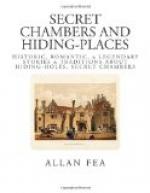Little daunted, the lady, with great presence of mind, made no objection whatever—indeed, facilitated their operations by personally conducting them over the mansion. Here, as in so many other instances, the secret room was entered from the principal bedroom, and in inspecting the latter the suspicion of the Roundheads was in some way or another aroused, so here they determined to remain for the rest of the night.
An ample supper and a good store of wine (which, by the way, had been carefully drugged) was sent up to the unwelcome visitors, and in due course the drink effected its purpose—its victims dropped off one by one, until the whole party lay like logs upon the floor. Mrs. Arthur Jones then crept in, having even to step over the bodies of the inanimate Roundheads, released her husband, and a fresh horse being in readiness, by the time the effects of the wine had worn off the Royalist captain was far beyond their reach.
The secret room is located in the front of the building, and has now been converted into a very, comfortable little dressing-room, preserving its original oak panelling, and otherwise but little altered, with the exception of the entry to it, which is now an ordinary door.
Chastleton is the beau ideal of an ancestral hall. The grand old gabled house, with its lofty square towers, its Jacobean entrance gateway and dovecote, and the fantastically clipped box-trees and sun-dial of its quaint old-fashioned garden, possesses a charm which few other ancient mansions can boast, and this charm lies in its perfectly unaltered state throughout, even to the minutest detail. Interior and exterior alike, everything presents an appearance exactly as it did when it was erected and furnished by Walter Jones, Esquire, between the years 1603 and 1630. The estate originally was held by Robert Catesby, who sold the house to provide funds for carrying on the notorious conspiracy.
Among its most valued relics is a Bible given by Charles I. when on the scaffold to Bishop Juxon, who lived at Little Compton manor house, near Chastleton. This Bible was always used by the bishop at the Divine services, which at one time were held in the great hall of the latter house. Other relics of the martyr-king used to be at Little Compton—viz. some beams of the Whitehall scaffold, whose exact position has occasioned so much controversy. The velvet armchair and footstool used by the King during his memorable trial were also preserved here, but of late years have found a home at Moreton-in-the-Marsh, some six miles away. Visitors to that interesting collection shown in London some years ago—the Stuart Exhibition—may remember this venerable armchair of such sad association.
[Illustration: CHASTLETON]
[Illustration: ENTRANCE DOOR, CHASTLETON]
It may be here stated that after Charles I.’s execution, Juxon lived for a time in Sussex at an old mansion still extant, Albourne Place, not far from Hurstpierpoint. We mention this from the fact that a priest’s hole was discovered there some few years ago. It was found in opening a communication between two rooms, and originally it could only be reached by steps projecting from the inner walls of a chimney.




